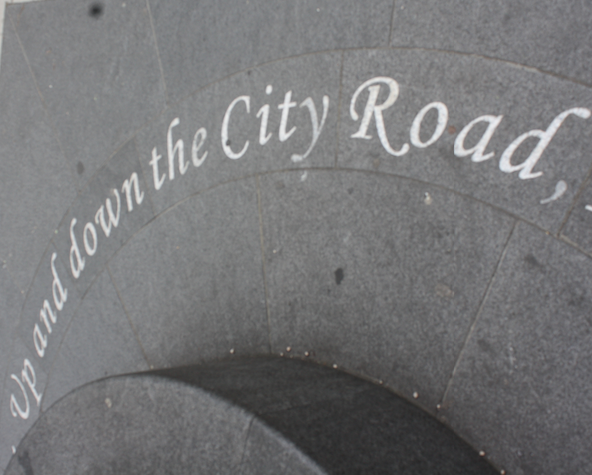Post
REPORT | Up and Down the City Road
30 May 2019
"Up and down the City Road, In and out the Eagle, That’s the way the Money goes. Pop goes the weasel." Jo East went with Rob Smith on the recent London Society walk along this fascinating (and rapidly changing) stretch of north London. Rob Smith was soon giving his explanation of the nursery rhyme on our second stop on a walk that took us down from The Angel to Old Street. Rob does this walk as part of Footprints of London on a regular basis so this review will try to avoid too many specifics but instead give a flavour of the two hour walk, adding in some architectural references for the buildings we passed.
We start by being ushered away from the bustle outside Angel tube station through a narrow passage into the triangular square of Angel Square. This splendid bit of PoMo (Rock Townsend 1991) has as its centre an Obelisk to Thomas Paine in tribute to “The Rights of Man” that was written at The Angel in 1791 so seen as a fitting adornment by the developers at the time. It was however to another man that Rob turns our attention. Charles Dingley who is responsible for creating City Road was it turns out that much beloved London archetype – The Spiv. Making his money in import/export he ploughed some of his wealth into this the “World’s first bypass” allowing goods and people going to and from the North directly into the City (for a toll) to avoid the constant stream of cattle flooding down the New Road – What we now know today variously as Pentonville/Euston/Marylebone. Diverting down the Goswell Road we take in some of the remaining warehouse office type buildings that brought industry to this area before cutting back onto the City Road at the imposing old pile of St Mark’s Hospital (1896 Rowland Plumbe) that was first a hospital for fistula complaints before morphing into the world’s first specialist cancer hospital. Carrying down the City road we take in the site of the City Road tube station and the new high tower development around City Road Basin. One of these Canaletto (UNstudio 2015) was apparently named for its proximity to the Canal unaware of the fact that Canaletto did paint this view in the 18th Century taking in the fine vista towards the City. Development of a different kind was shown by our stop outside the Victoria Miro Gallery – A re-purposed furniture warehouse (Claudio Silvestrin 2005) showing contemporary art and numbering Grayson Perry as one of her clients. Passing through Windsor Terrace, the “home” of Mr Micawber and highlighting Dickens’ connection to the area and then the strangely undeveloped vast site of St Luke’s Workhouse we arrived in Shepherdess Place. Containing both the Eagle pub (1900 Architect Unknown) (NOT the Eagle referred to in the rhyme which was a pleasure garden) and the Shepherdess Café – a 1950s? greasy spoon beloved of both film makers and film stars alike. Rob tells us stories of both including the high and low culture that went on in the much larger building that stood on the site from 1825-1899 and the famous people immortalised in photos on the café’s walls. Passing another British Institution in the shape of the first Lipton’s tea Headquarters we come into Westland Place. In1910s it was home to an infamous band of pickpockets and muggers known as the Titanic Mob. Given that it’s now famed for being the site of Jamie Oliver’s 15 Restaurant it shows how the area has changed over the last 100 years with the greatest changes coming in the last 30. As we near the end of our walk we take in Moorfields Eye Hospital. Founded in 1805, it moved to its current City Road location in 1899. This world renowned Hospital is due to move again to a purpose built site at Kings Cross. (Penoyre & Prasad and White Arkitekter being just announced this year as the Architects) Although a much needed upgrade it will bring yet more change to the area, losing one of its major employers. Around the corner Rob showed us the Old Fountain pub built over the site of London’s first swimming pool. A Mr Kemp giving a marketing spin that any advertising agency would be proud of, turning the “Perilous Pond” into the “Peerless Pool” in the early 1800s. Finishing at the Old Street roundabout Rob pointed out the pillars for the intended flyover that would have made the place “a whole lot worse – If you can imagine that” it did however provide one of the places for The Beatles in their “Mad Day Out” photoshoot with Don McCullin. It seems inconceivable today that it was chosen for its being away from the main hubbub of the City. The Silicon Roundabout of today being another hub of tall buildings shooting up and trendy bars and restaurants to serve the tech companies that have made it their home. I hadn’t been to this area for 20 years and never walked down the City Road so was delighted to hear the fascinating history of what was said to be the “Finest road in London” by an admirer in 1776. Rob takes this and other London walks regularly and you can find details at http://footprintsoflondon.com/walks.
